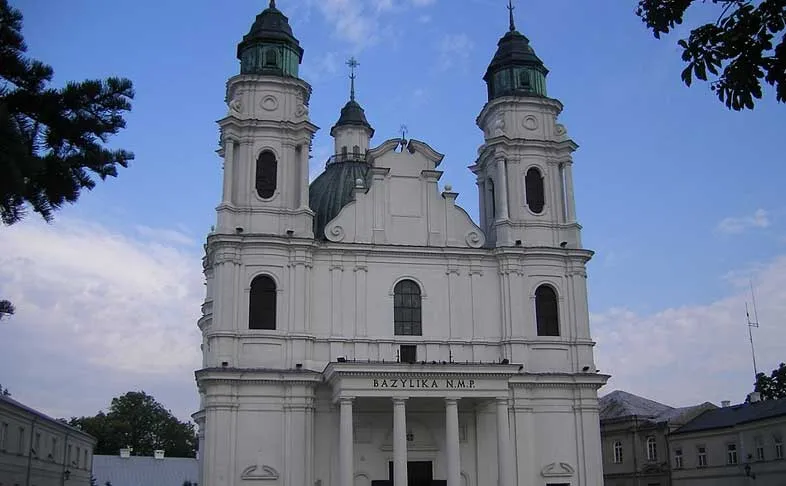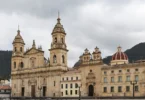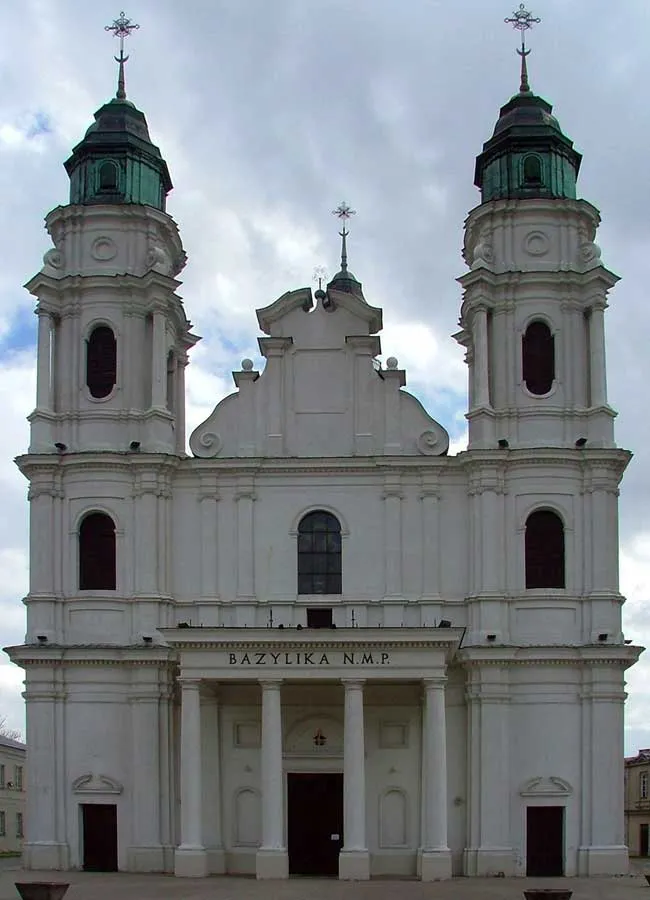
Introduction
The Basilica of the Birth of the Virgin Mary (Polish: Bazylika Narodzenia Najświętszej Maryi Panny, Ukrainian: Собор Різдва Пресвятої Богородиці) is a church and monastery complex of the Catholic Church located in the Polish city of Chełm. The church and the courtyard of the basilica stand in the centre of Chełm on Chełm Hill (also called Cathedral Hill or Castle Hill).
Over its history, the church has been Ukrainian Orthodox, Ukrainian Greek Catholic (previously known as Ruthenian Uniate), and Latin Catholic. Surrounding the basilica’s grounds is a city park and a cemetery.
The basilica is a former complex of Orthodox Church and Basilian Monastery. It was founded in the first half of the 13th century by Danylo Romanowych and served as an Orthodox Church and then as a Greek Catholic Church. The present church was founded in 1735-56 by the Greek Catholic Chełm bishop Philip Włodkowic and was built according to the plans of Paweł Fontana. It is a late baroque church built in the shape of a Latin cross, three-aisled basilica with a huge eight-part dome.
History of Basilica of the Blessed Virgin Mary, Chełm
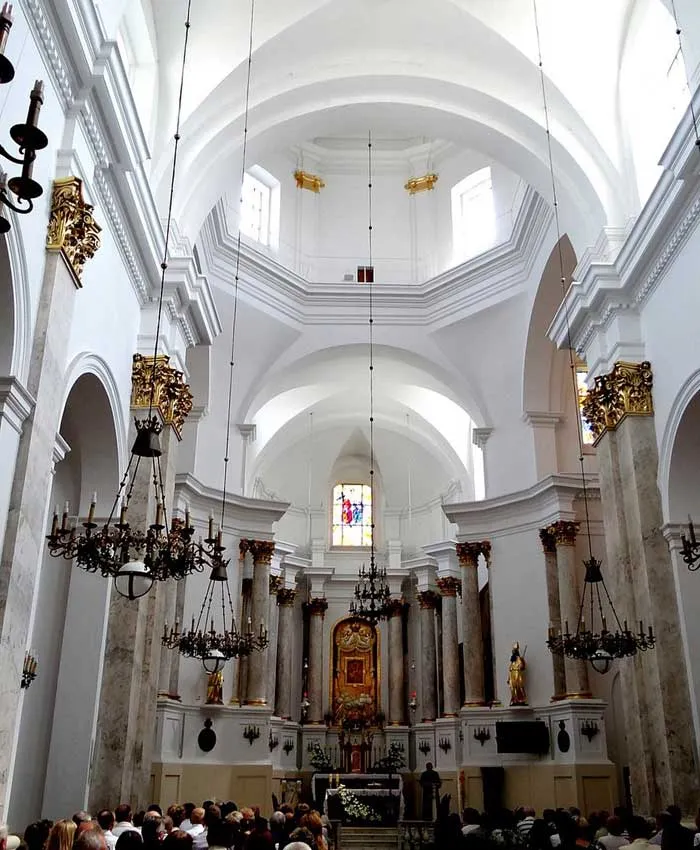
A former Greek Catholic Cathedral and currently the Parish church, the Basilica of the Virgin Mary stands on the site of an Orthodox church of the same name, founded by Daniel Romanowicz in about 1260.
After a fire in 1640, it was rebuilt by bishop Metody Terlecki who introduced some small changes. As the years went by, the church needed to be enlarged and in 1711 bishop Józef Lewicki began repair works and built a transept. Unfortunately, it turned out that the work was done so unreliably that the building was close to collapse.
The successor of Lewicki, bishop Felicjan Wołodkowicz considered the building’s condition to be so bad that renovation was no longer an option and therefore commissioned its demolition. In 1735 the work began and a completely new, much bigger church was built, which was ready in 1756. That time, in curia sat on bishop Maksymilian Rylo, who finished the investment and founded rich decoration of sanctuary.
On 15 September 1765 the church was the place of the coronation of the marvellous painting of the Our Lady of Chełm. The painting was revered throughout the country because of its connection with the victory in the Battle of Berestechko that took place in 1651. The painting was taken by Russian forces in 1915 and is currently kept in Lutsk, Ukraine.
In 1802 the cathedral was consumed by fire but its walls stayed intact for a long time. Finally, in 1827 bishop Ferdynand Dąbrowa-Ciechanowski, at the expense of the treasury of the Kingdom of Poland, rebuilt the sanctuary. This rebuilt structure survived the Russian Empire’s forcible conversion of the Chełm Eparchy to Eastern Orthodoxy in May 1875.
After the incursion of Austrian troops into Chełm (in 1915), the cathedral was used as an army warehouse. In May 1919 the Polish authorities donated the church to Catholic clergy. In May 1940 the German occupation authorities gave the cathedral to Ukrainians. In November, the same year, the Orthodox diocese was formed. Soon after the liberation of Poland, 24 August 1944, by the decision of the Polish Committee of National Liberation, Chełm’s cathedral was given to the Catholic Church.
Architecture
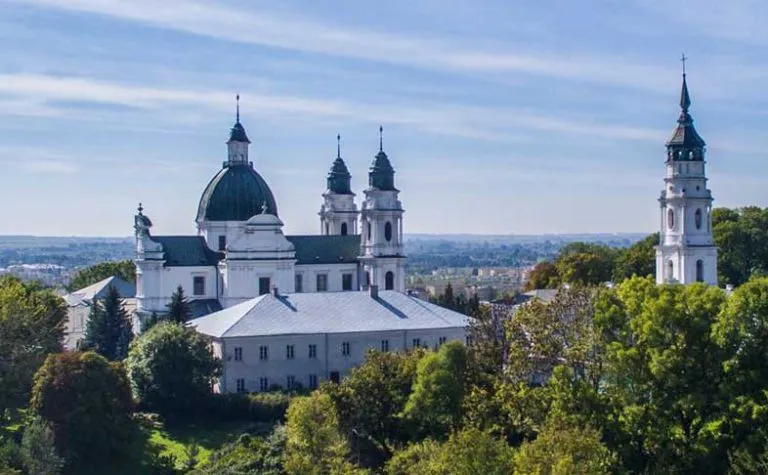
It is a late baroque church built in the shape of a Latin cross, and is a three-aisled basilica with a huge eight-part dome. The interior decoration is modest—the church was twice changed into a Russian Orthodox Church (1875–1918 and 1940–1944). In front of the basilica there is a detached belfry from 1878 which was rebuilt and heightened during the interwar period.
Next to the basilica there is a Basilian Monastery founded in 1640-49 by Bishops Metodiusz Terlecki and Jakub Susza—the principal of the first Chełm secondary school. Nowadays it serves as a living quarter. In the main altar there is a copy of a painting of the Chełm Virgin Mary that went missing during the First World War and a late baroque silver antependium showing the king Jan Kazimierz paying tributes to the Chełm Virgin Mary after winning the battle at Beresteczko in 1651.
The interior of the Basilica
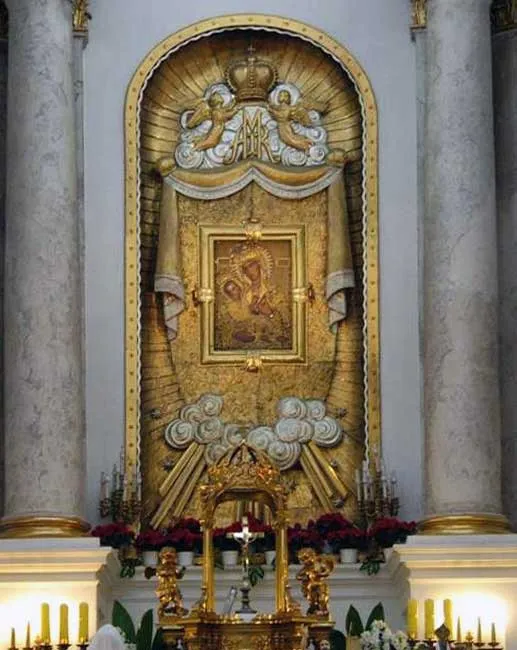
The interior of the temple has barrel-cruciform vaults with lunettes, and cross vaults in the aisles. The architectural decor is made of Corinthian and Ionic pilasters, and in the presbytery and cadet – Corinthian columns along the wall and richly profiled cornices and window frames. In the window above the main altar there is a stained glass window depicting the Holy Trinity, while the stained glass window above the choir is a replica of the painting of Our Lady of Chełm (both from 1988).
The equipment is new and quite modest; from the former one should mention, first of all, a wonderful monument of the art of jewelery – the antependium of the main altar, trimmed in silver plate, made in 1750 in the workshop of master W. Jöde in Gdańsk, commissioned by the Basilians of Chełm, depicting the homage scene of the Polish knights in front of the painting of Our Lady of Chełm, after the victory near Berestechko over the Cossacks and Tatars in 1651.
The Miraculous Image of Our Lady of Chełm
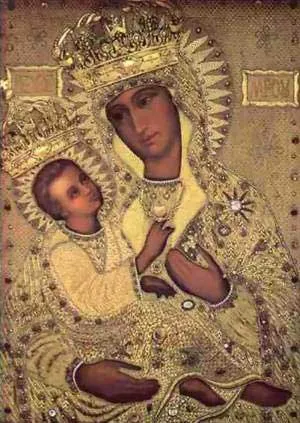
There are at least a few thirteenth-century hypotheses as to how the image (icon) of Our Lady of Chełm came to Chełm. One of them, written down by Bishop Jakub Susza, states that it was brought from Cherson to the city on the Uherka river by Prince Włodzimierz of Kiev and presented to the church in Chełm. Another proves that the painting was brought from the Kiev monastery by the sister of Daniel Romanowicz Halicki. There is also one according to which Prince Włodzimierz brought it from Owruch to Chełm.
It is also said that the icon of the Mother of God was given to Daniel by Sister Theodora of the Fiedovsky Monastery. The oldest legend that has survived to this day – from the beginning of the 11th century – says that the painting was to be brought from Byzantium as a dowry gift for the wife of the Ruthenian prince Vladimir.
However, these are only guesses. It is certain, however, that already in the thirteenth century the image of the Mother of God was already in Chełm. Such information is provided by the Polish chronicler Długosz, who writes that in 1262 Lew, son of Daniel, donated his village for the church and the image of the Blessed Virgin. There is also no doubt about the material on which the icon was made. Długosz directly states that the painting was painted on a cypress tree.
Jakub Susza, the Uniate bishop, recorded its dimensions: “Along this Holy Image, one and a half cubits and almost a quarter; in breadth it is a quarter-and-a-half; The flesh is said to be two fingers thick… Bishop Susza is also the author of the description of the painting: “The face of the Virgin and Mother of God is serious in modesty, terrible in seriousness and somehow pleasant in fear, and occultis stimulis penetrating human hearts. Mother and Virgin painted up to the hips, the whole son of Jesus, with a dark red outer dress, supposedly interspersed with gold, and a dark blue inner one, clothed. Around the heads themselves, on smoothed silver, flowers are also supposedly beautifully painted.
However, the author of this masterpiece remains a mystery. It is true that medieval sources believe that it could have been Saint Luke the Evangelist, but as in the case of the image of Our Lady of Czestochowa, this seems unlikely. The fact is, however, that the image was venerated by the faithful not only from Chełm and the Chełm region. Kazimierz Czernicki in the book “Chełm past and souvenirs” wrote that Bogurodzica was also known in Podlasie and Volhynia.
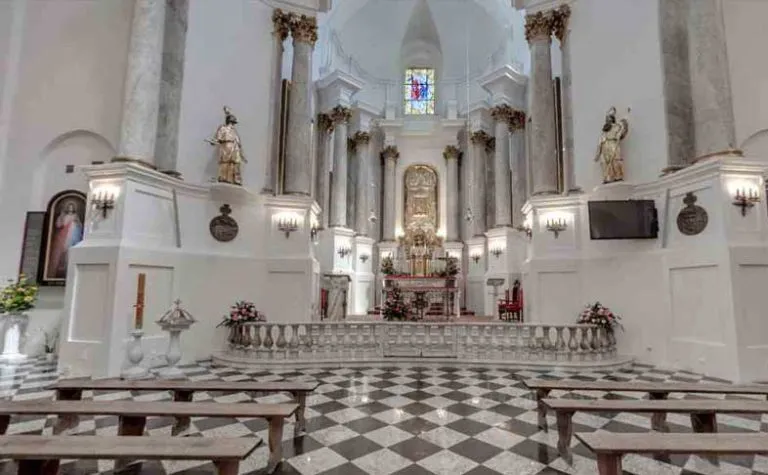
According to the same source, in 1646 a monk of the Chełm monastery of St. Basil the Great – Jakub Susza, later the bishop of Chełm, published a booklet with a description of the 100 most important miracles that took place as a result of requests addressed to Mary. In the same year (July 22), a commission chaired by Paweł Owłuczyński, Bishop of Sambor and coadjutor in Przemyśl considered the image of Our Lady of Chełm to be miraculous. In 1765, the first coronation of the Image took place…
In the history of the painting, he has left Chełm several times. He was present on the battlefields near Beresteczko and the war camp of King Michał Korybut Wiśniowiecki, he was exhibited in the Lviv cathedral, he was in the castle chapel in Warsaw, in the Basilian monastery in Żydczyn and Kolemczyce on the Bug (today’s Chełm district), the painting was also exhibited in Zamość. Polish kings bowed before it, and in 1888 even Tsar Alexander II and his family kissed the miraculous icon.
In 1915, the Russians living in Chełm, fleeing from the Austrian army, left deep into Russia. Then the Miraculous Image of Our Lady of Chełm went to Moscow, where it stayed for almost three years. There is a high probability that the miraculous painting from Chełm was taken by the proto-jersey Mikołaj Gankiewicz.
In 1918, after the proclamation of the Ukrainian National Republic, he was transported to Kiev, and then, together with M. Korniłowicz, they secretly transported the painting to the church of the Women’s Floriv Monastery in Podolia. In the 1920s and 1930s, for fear of confiscation, the icon was kept in private homes. For example, the Chełm Miraculous Icon was sheltered by Natalia Polońska-Wasilenko, a well-known historian of the time, and then on July 16, 1933, it ended up in the hands of protojerey Anatolij Junak.
From February 1942 to September 1943, the painting was restored, and the work was done by the art professor Mikołaj Prachow. In September 1943, the icon was returned to Chełm. The Madonna and Child from Chełm were brought by Anatoli Junak and Professor WD Bołkanowicz, Deputy Mayor of Kiev. Initially, it was exhibited in the archbishop’s palace, and then in the church of St. Andrew (today’s church of St. Andrew, Franciscan fathers). On October 3, 1943, the Miraculous Image was transferred to the Cathedral on Wysoka Górka.
Organ
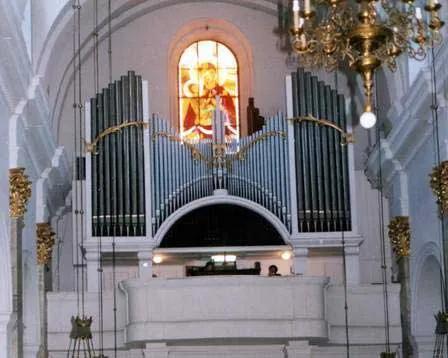
From the chronicle of the organ of February 2, 1946. Fr. Pastor Marceli Mrozek informed from the pulpit about the possibility of building an organ in the Cathedral, because Wiesław Biernacki’s company in Krakow had started work. In the first version, a new 41-voice organ was to be built, but 3 manuals were built on October 22, 1946.
Mr. Biernacki sent a letter in which he writes that the company received for sale an organ with 40 stops, 3 manuals and a pedal, a cone-pneumatic system with 3 tongue stops. November 14, 1946 In 2006, a contract was signed with the Biernacki i Spółka based in Krakow for the assembly of these organs in the Cathedral on the Chełm Mountain.
Bells on Mount Chełmska
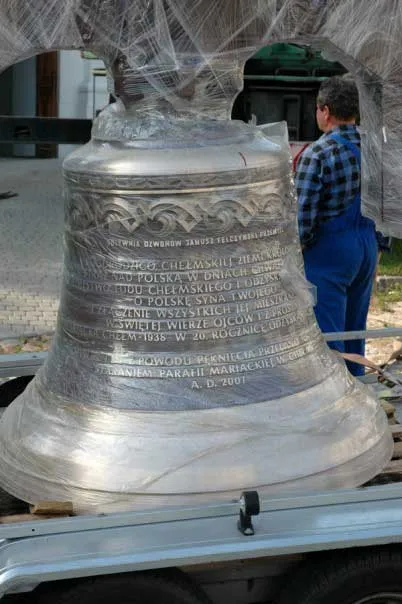
The campanile, or bell tower, on the north front, houses the nineteen-ton Savoyarde bell (one of the world’s heaviest), cast in 1895 in Annecy. It alludes to the attachment of Savoy to France in 1860.
The porch of the south facade, the main entrance, is loaded with sculpture combining religious and French national themes. It is topped with a statue representing the Sacred Heart of Christ. The arches of the facade are decorated with two equestrian statues of French national saints Joan of Arc (1927) and King Saint Louis IX, both executed in bronze by Hippolyte Lefèbvre.
The white stone of Sacré-Cœur is travertine limestone of a type called Chateau-Landon, quarried in Souppes-sur-Loing, in Seine-et-Marne, France. The particular quality of this stone is that it is extremely hard with a fine grain, and exudes calcite on contact with rainwater, making it exceptionally white.
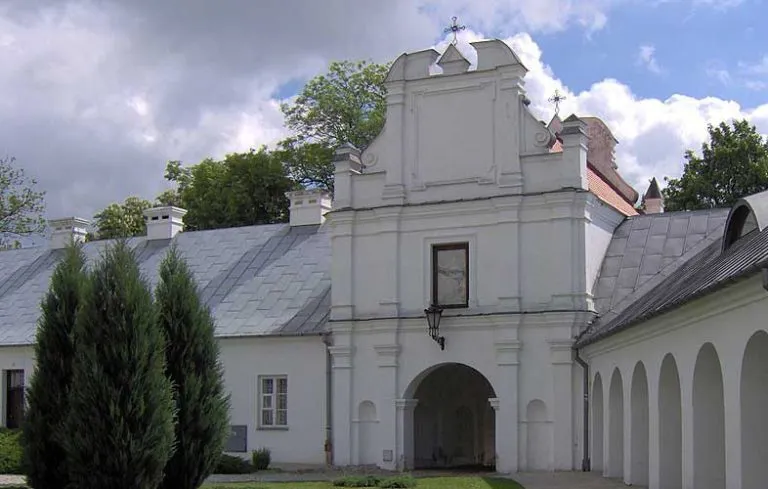
Surroundings
There are also many monuments surrounding the Basilica which are connected with the history of Chełm. The most famous are:
- Uściługska Gate [‘Brama Uściłuska’] (built in the 17th-18th centuries)
- The Uniate Bishops Palace [‘Pałac biskupów unickich’] (built in 1711)
- The Basilian Monastery [‘Klasztor Bazylianów’] (1640–1649)
- The Building of the Orthodox Virgin Mary Brotherhood in Chełm [‘Budynek Chełmskiego Prawosławnego Bractwa bogurodzicy’] (end of 19th century)
- The Belfry [‘Dzwonnica’] (1878)
Feast Day – 7th & 8th September
The Festival of the Virgin Mary (Our Lady of Chełm) is celebrated at the basilica on every 7th and 8th of September. Many groups of pilgrims arrive to Chełm to take part in the indulgence offered in relation to the festival.
Mass Time
Weekdays
Saturdays
Sundays
Church Visiting Time
Contact Info
Lubelska 2, 22-100 Chełm, Poland.
Phone No.
Tel : +48 82 565 24 75
Accommodations
How to reach the Basilica
Lublin Airport is located about 10 km east of central Lublin, adjacent to the town of Świdnik, Poland is the nearby Airport to the Basilica.
Chełm Train Station in Chełm, Poland is the nearby Train Station to the Basilica.

